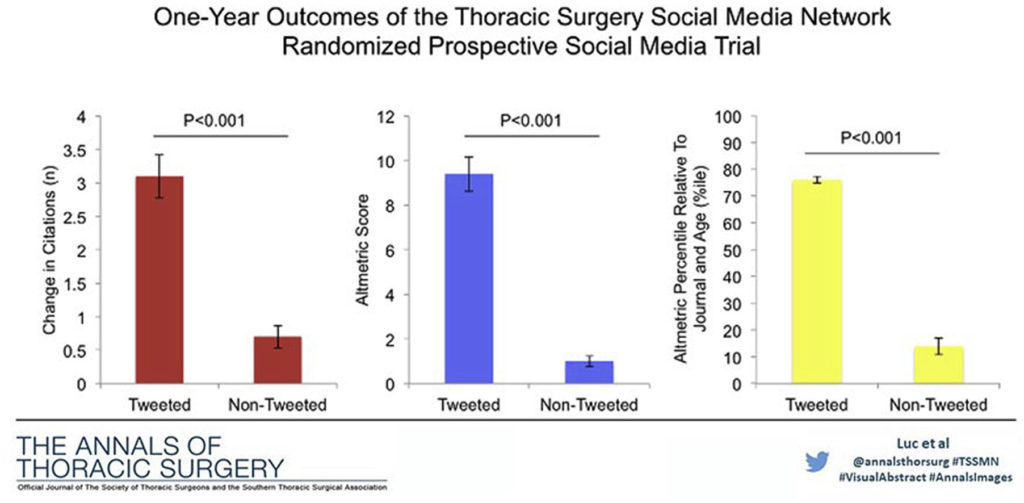Scientists hoping to boost their h-index and get more citations for their work need look no further than their cell phones, according to a new study from the Thoracic Surgery Social Media Network (TSSMN). Their results show that the key to increasing a paper’s citations may be as simple as a 280-character tweet.
To tweet or not to tweet?
In recent years, Twitter has increasingly become a hub for academics to share their research and forge collaborations. Major scientific publishers now offer guides for researchers venturing for the first time into the Twitterverse, and “going viral” is a legitimate and important method for scientists to share their research with the public.
But does tweeting out an article actually affect how it will be received within the scientific community? And for scientists hoping to boost their citations — where citations are a measure of how many other researchers are aware of and building upon their work — will tweeting about scientific research make a difference?
To find out, researchers from the University of British Columbia, the University of Manitoba, the University of Toronto, and other members of the TSSMN tweeted about a randomized set of articles and tracked citations and article metrics over the course of a year. Their results were published in The Annals of Thoracic Surgery.
The team chose 112 scientific research articles published in The Annals of Thoracic Surgery and The Journal of Thoracic and Cardiovascular Surgery from 2017-2018, and randomly divided these articles up into two groups — those that would be tweeted about via TSSMN, and those that would not. At the start of their study, there were no significant differences in baseline citations, prior tweets, or other article metric between the two randomized groups.
The study protocol involved one TSSMN delegate tweeting about four articles per day, and all other TSSMN delegates retweeting each of these four articles. Combined, the TSSMN delegates had a Twitter following of 52,893 individuals, and were instructed not to interact with the tweet in any way aside from retweeting.
Tweeting increases citations and Altmetric scores
After a year, the researchers returned to the 112 papers chosen for the study and compared the change in citations and Altmetric scores — a way to measure the volume and type of attention received by a research output — for each group. They found a significant increase in both cases for the papers that had been tweeted about, with Altmetric scores increasing by 9.4 and citations increasing by 3.1 compared to increases of 1.0 and 0.7 respectively for non-tweeted articles.

“Social media has revolutionized the ways in which we communicate, transcending chronologic and geographic boundaries, while enabling the rapid dissemination of information worldwide,” said Jessica G.Y. Luc, cardiac surgery resident at the University of British Columbia and lead author of the study, and Mara Antonoff, assistant professor of Thoracic and Cardiovascular Surgery at the University of Texas MD Anderson Cancer Center, founder of the TSSMN and senior PI of the study, in an email to Research2Reality.
“For researchers, social media has a role in creating one’s online persona, educating patients and colleagues, interacting with policymakers and the media, engaging in networking and mentorship, and heralding the scientific and clinical achievements of our field.”
While their study focused specifically on Twitter, the TSSMN plans to expand their reach to other social media platforms going forward.
“Regardless of the modality for dissemination, our study suggests that greater public accessibility for a public and scientific readership may contribute to higher Altmetric score, Altmetric percentile, and, ultimately, citations,” Luc and Antonoff said.
“The next steps for TSSMN include expanding it to other social media platforms beyond Twitter to seek to engage an even broader audience than we currently reach.”
Benefits beyond increased citations
Their results highlight the importance of Twitter not just as a platform for communicating science with the public, but also as a means of disseminating research within scientific communities.
For busy scientific researchers, a 280-character summary of a research article may prove to be much more eye-catching than a longer abstract or a university’s press release article. What’s more, it may prove to be the beginning of entirely new scientific studies and collaborations.
“We would encourage researchers to consider taking the extra step with their manuscripts, whether it is to write a tweet, tweetorial, social media post, video, or blog post, to provide context for their study in an easy to understand manner,” Luc and Antonoff added.
“This can help improve the understanding others have of your article, and might just serve as a launchpad for further studies and subsequent citations.”









































